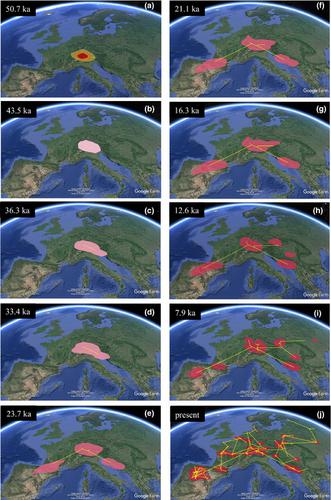当前位置:
X-MOL 学术
›
J. Zool. Syst. Evol. Res.
›
论文详情
Our official English website, www.x-mol.net, welcomes your
feedback! (Note: you will need to create a separate account there.)
A complex scenario of glacial survival in Mediterranean and continental refugia of a temperate continental vole species (Microtus arvalis) in Europe
Journal of Zoological Systematics and Evolutionary Research ( IF 2.0 ) Pub Date : 2019-11-25 , DOI: 10.1111/jzs.12323 Jesús T. García 1 , Julio Domínguez‐Villaseñor 1 , Fernando Alda 2 , María Calero‐Riestra 1 , Pedro Pérez Olea 3 , Juan Antonio Fargallo 4 , Jesús Martínez‐Padilla 5 , Jesús Herranz 3 , Juan José Oñate 3 , Ana Santamaría 1 , Yoav Motro 6 , Carole Attie 7 , Vincent Bretagnolle 8, 9 , Juan Delibes 10 , Javier Viñuela 1
Journal of Zoological Systematics and Evolutionary Research ( IF 2.0 ) Pub Date : 2019-11-25 , DOI: 10.1111/jzs.12323 Jesús T. García 1 , Julio Domínguez‐Villaseñor 1 , Fernando Alda 2 , María Calero‐Riestra 1 , Pedro Pérez Olea 3 , Juan Antonio Fargallo 4 , Jesús Martínez‐Padilla 5 , Jesús Herranz 3 , Juan José Oñate 3 , Ana Santamaría 1 , Yoav Motro 6 , Carole Attie 7 , Vincent Bretagnolle 8, 9 , Juan Delibes 10 , Javier Viñuela 1
Affiliation

|
The role of glacial refugia in shaping contemporary species distribution is a long‐standing question in phylogeography and evolutionary ecology. Recent studies are questioning previous paradigms on glacial refugia and postglacial recolonization pathways in Europe, and more flexible phylogeographic scenarios have been proposed. We used the widespread common vole Microtus arvalis as a model to investigate the origin, locations of glacial refugia, and dispersal pathways, in the group of “Continental” species in Europe. We used a Bayesian spatiotemporal diffusion analysis (relaxed random walk model) of cytochrome b sequences across the species range, including newly collected individuals from 10 Iberian localities and published sequences from 68 localities across 22 European countries. Our data suggest that the species originated in Central Europe, and we revealed the location of multiple refugia (in both southern peninsulas and continental regions) for this continental model species. Our results confirm the monophyly of Iberian voles and the pre‐LGM divergence between Iberian and European voles. We found evidence of restricted postglacial dispersal from refugia in Mediterranean peninsulas. We inferred a complex evolutionary and demographic history of M. arvalis in Europe over the last 50,000 years that does not adequately fit previous glacial refugial scenarios. The phylogeography of M. arvalis provides a paradigm of ice‐age survival of a temperate continental species in western and eastern Mediterranean peninsulas (sources of endemism) and multiple continental regions (sources of postglacial spread). Our findings also provide support for a major role of large European river systems in shaping geographic boundaries of M. arvalis in Europe.
中文翻译:

地中海冰河生存和欧洲温带田鼠物种(田鼠(Microtus arvalis))的大陆避难所的复杂情况
在生态学和进化生态学中,冰川避难所在塑造当代物种分布中的作用是一个长期存在的问题。最近的研究对欧洲关于冰re和冰河后重新定殖途径的先前范例提出了质疑,并且已经提出了更加灵活的系统地理学方案。我们以普遍的田鼠田鼠为模型,研究了欧洲“大陆”物种群的起源,冰川避难所的位置以及传播途径。我们使用了细胞色素b的贝叶斯时空扩散分析(松弛随机游走模型)物种范围内的序列,包括来自10个伊比利亚地区的新近收集的个体以及来自22个欧洲国家的68个地区的已发布序列。我们的数据表明该物种起源于中欧,并且我们揭示了该大陆模式物种的多个避难所(在南部半岛和大陆地区)的位置。我们的结果证实了伊比利亚田鼠的单方面性以及LGM之前的伊比利亚田鼠和欧洲田鼠之间的分歧。我们发现了来自地中海半岛避难所的限制的冰川后扩散的证据。我们推测的复杂的演化和人口史M. arvalis在欧洲,在过去5万年不充分符合以前的冰川refugial场景。室壁藻的系统地理学提供了地中海西部和东部半岛(特有物种的来源)和多个大陆地区(冰川后扩散的来源)的温带大陆物种在冰龄中生存的范例。我们的研究结果也为欧洲大型河流系统在塑造欧洲野蛮树的地理边界方面的主要作用提供支持。
更新日期:2019-11-25
中文翻译:

地中海冰河生存和欧洲温带田鼠物种(田鼠(Microtus arvalis))的大陆避难所的复杂情况
在生态学和进化生态学中,冰川避难所在塑造当代物种分布中的作用是一个长期存在的问题。最近的研究对欧洲关于冰re和冰河后重新定殖途径的先前范例提出了质疑,并且已经提出了更加灵活的系统地理学方案。我们以普遍的田鼠田鼠为模型,研究了欧洲“大陆”物种群的起源,冰川避难所的位置以及传播途径。我们使用了细胞色素b的贝叶斯时空扩散分析(松弛随机游走模型)物种范围内的序列,包括来自10个伊比利亚地区的新近收集的个体以及来自22个欧洲国家的68个地区的已发布序列。我们的数据表明该物种起源于中欧,并且我们揭示了该大陆模式物种的多个避难所(在南部半岛和大陆地区)的位置。我们的结果证实了伊比利亚田鼠的单方面性以及LGM之前的伊比利亚田鼠和欧洲田鼠之间的分歧。我们发现了来自地中海半岛避难所的限制的冰川后扩散的证据。我们推测的复杂的演化和人口史M. arvalis在欧洲,在过去5万年不充分符合以前的冰川refugial场景。室壁藻的系统地理学提供了地中海西部和东部半岛(特有物种的来源)和多个大陆地区(冰川后扩散的来源)的温带大陆物种在冰龄中生存的范例。我们的研究结果也为欧洲大型河流系统在塑造欧洲野蛮树的地理边界方面的主要作用提供支持。











































 京公网安备 11010802027423号
京公网安备 11010802027423号